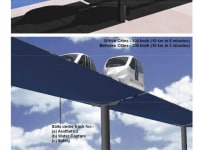The MonoCab VRT rapid transit system (patents pending) is different than other systems that have been proposed in that passenger and freight services coexist on the same system. It also services both local and long distance demand.
Transit speeds are 100 km/h (60 mph) in the urban environment and 200 km/h (120 mph) elsewhere. The vehicle mechanical components are sourced from the automotive and trucking industries. All mechanical components are housed within the vehicle bodywork, hence operational noise is minimized.
The bi-directional track is constructed using commercially available, large steel beams a minimum of 5 metres (16 feet) above ground and always above flood level. The track can also support other services such as water, oil and gas pipelines, communication cabling and solar panels.
The vehicles are powered by electric motors that have a far higher energy efficiency than petrol or diesel motors. The power is supplied to the vehicles by rails hidden between the tracks.
The vehicles operate automatically (no drivers) and on demand. There are no schedules. Vehicles travel from their point of origin to their destination without any intermediate stops. This method of operation enhances personal safety.
Only extreme weather events such as cyclones may affect the system’s operation. As the track is elevated, there is no conflict with vehicular or pedestrian traffic.
The system is a practical, cheaper alternative to road, rail and air. The system can be constructed significantly faster than equivalent road or rail (only a column every 30 - 35 metres [100 - 115 feet] at ground level) with minimal disruption to local communities. Track construction estimates in Australia are in the order of AUD 6 million/km (AUD 9.6 million/mile) excluding vehicles.
This system will dramatically reduce the endemic traffic congestion in many parts of the world.
The optional sails under the track (originally for aesthetics) harvest potable water at the rate of 900 ML (237,000 U.S. gallons) per 100 km (62.5 miles) for each 1000 mm (39") of rain. This provides the annual water requirements for 12,300 people.
MonoCab VRT passenger trip times for 1000 km (625 miles) are approximately equal to airline trip times from point of origin (home or office) to the destination CBD. For lesser distances, MonoCab VRT is faster than air. MonoCab VRT is a 24/7, on demand service and will not be subject to curfews as are airports.
Australian passenger fares are 45% of equivalent rail, bus and average airline fares. The system is profitable at these fares with NO Government subsidies for either infrastructure or fares.
The public love the concept. During displays of a trailer mounted model on the Gold Coast, written responses were received to two questions (a) “Would you like to see this system on the Gold Coast and South East Queensland?” (99.42% YES) and (b) “Please rate the concept out of 10”. (average rating - 9.54 out of 10).
You can’t get much better than that!!
Like this entry?
-
About the Entrant
- Name:David Whittaker
- Type of entry:individual
- Software used for this entry:AutoCAD
- Patent status:pending








